Herding the wild
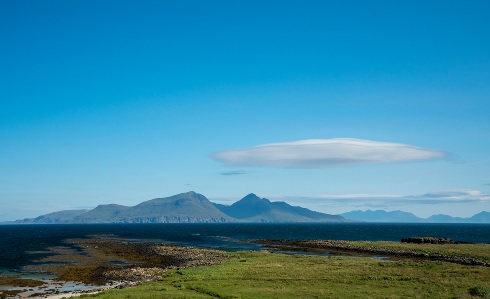
Iain Gordon explores whether the concept of ‘rewilding lite’ can help us restore the biodiversity of agricultural land where the return of large herbivores and predators is not possible
May 27th 2022
Across the UK and Europe land is being abandoned at an increasing rate. As people move from rural to urban areas, or farming families decide to no longer practise agriculture, the abandoned land becomes revegetated. This can be good for biodiversity, but also comes with risks.
The wildfires that recently ravaged large swathes of southern Europe were often in areas abandoned by agriculture, where biomass had accumulated and increased the risk of large fires. On such land weeds can outcompete native species and leave large areas covered in a homogeneous blanket of vegetation, reducing biodiversity and the ways people can interact with the land.
As countries struggle with what to do with abandoned land and other environmental problems, there has been a growing movement towards rewilding projects, which aim to restore ecosystems to a ‘wild’ and natural state. Large rewilding projects are being implemented across Europe and the UK, such as the Affric Highlands Initiative in the Scottish Highlands. There, by planting trees, creating corridors along rivers, restoring peat bogs and supporting wildlife-friendly farming practices, it is hoped that populations of salmon, trout, ospreys, otters, golden eagles, red grouse, short-eared owls and mountain hares will begin to thrive over 200,000 hectares of former farm land.
The purest form of rewilding (rewilding max) first arose in academic literature in the 1990s, particularly from North America with work from the likes of Michael Soulé and Reed Noss. Their focus was on the reintroduction of predators to the landscape in core protected areas, with corridors between them. In many rewilding projects the aim is to keep human influence away from the wild or wilderness areas – the US Wilderness Act (1964) talks of areas “untrammelled by man, where man is a visitor who does not remain”, while the Wild Europe Initiative 2013 states that “a wilderness is an area governed by natural processes … without intrusive or extractive human activity”. More broadly rewilding is defined as “large-scale biological and ecological restoration, emphasising recovery of native species … in natural patterns of abundance, to regain functional and resilient ecosystems”[1,2].
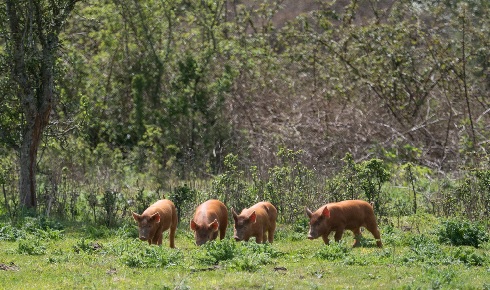 Tamworth pigs roam the Knepp Estate in the south of England
Tamworth pigs roam the Knepp Estate in the south of England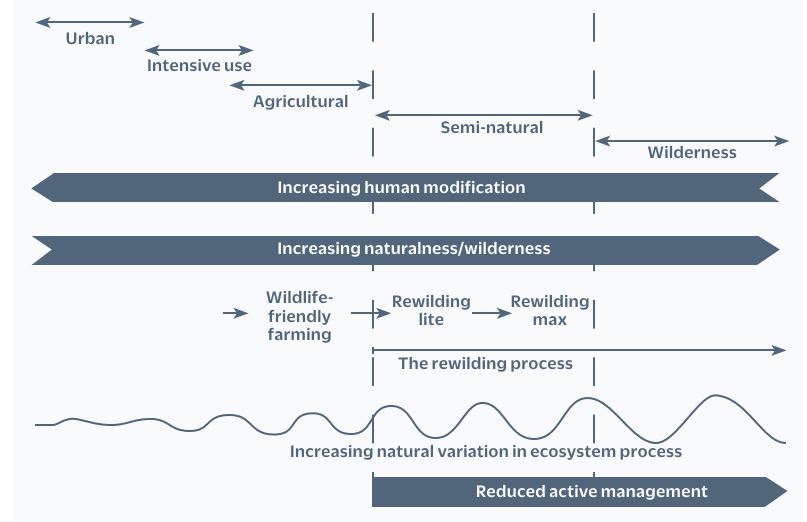 Fig.1 - the 'wilderness continuum'. Rewilding is the transitional process from active management to minimal intervention[7]. On this continuum, as the conditions become wilder, ecosystems are allowed to operate within a broader range of natural variation[8,4].
Fig.1 - the 'wilderness continuum'. Rewilding is the transitional process from active management to minimal intervention[7]. On this continuum, as the conditions become wilder, ecosystems are allowed to operate within a broader range of natural variation[8,4].Livestock are a well-known entity and humans have been managing them for thousands of years. Their introduction might, therefore, be more acceptable to people than bringing in large wild herbivores, especially when close to areas of human habitation. Livestock species derived from wild progenitors can have a range of functional ecological characteristics and feeding niches that would reinstate appropriate herbivory where it is not possible to reinstate native herbivores. When their numbers get too high the livestock can be removed – in effect humans act as the missing large carnivores – which can prevent the sight of starving animals that can sometimes be seen on rewilding sites where there is no intervention. Finally, the products from livestock can be sold, supporting the economy and jobs in regional areas that would otherwise be defunded and depopulated.
Gradual transition
Rewilding lite can also help manage the transition between abandoned land and a more wild state. An example is the beautiful Greater Côa Valley in Portugal, where over 100,000 hectares of previously agricultural land – covering river gorges, oak forests, rocky heathlands and scattered fields – is being returned to nature. In the first phases of the project traditional breeds of horses and cattle are being used to ensure that weeds and wildfires do not decimate the landscape. As native species of wild boar, red and roe deer recolonise the area, then the cattle can be removed to allow natural herbivory disturbance regimes to be reinstated.
There are, of course, potential downsides to the use of livestock in rewilding projects, including conflict with humans and their activities – for example, farming near the rewilding site. People may also be antagonistic towards the concept of rewilding in any form if it risks animal welfare. They might also see rewilding lite as not truly giving land back to nature and reject the concept as being too interventionist or just another form of agriculture. In many countries the use of livestock (and the sale of products from these animals) brings with it a whole bundle of legislation and regulations, which require intensive management of the animals, threatening to make the concept of rewilding burdensome and meaningless.
Some of these issues can be dealt with using traditional breeds/landraces that are adapted to the environments in which rewilding take place. For example, in my own early work on the Isle of Rum National Nature Reserve off the west coast of Scotland, free-ranging Highland cattle are used to manage coarse vegetation that would otherwise ingress into the biodiversity-rich acid grassland on the island, threatening wildflowers such as orchids and gentians. Likewise, the local breeds of Camargue horses and cattle roam across the wetlands near Arles in southern France. Alongside water-level management, their grazing reduces the cover of reeds, creating habitats in the marshlands for ducks and other wildlife.
In the south of England the Knepp Estate rewilding project uses a range of traditional livestock breeds, including Longhorn cattle, Exmoor ponies and Tamworth pigs in its 3,500-hectare grounds. They have seen dramatic improvements in the habitats for a range of species, such as nightingales and peregrine falcons, rare in other local contexts. At Knepp they have an abattoir and a butchery that sells meat from the animals on the rewilding project at a premium because of its environmental credentials.
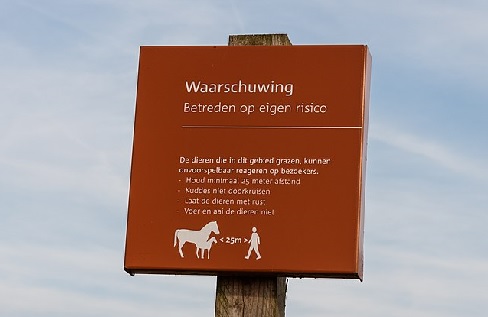
The use of livestock in rewilding projects does not always work, however. Oostvaardersplassen is a reclaimed polder in eastern Holland, where de-domesticated Heck cattle and Konik horses (a traditional breed) were left to fend for themselves in a landscape with deer, waterfowl and a range of other species. Heralded as a success in the early years because of the return of some iconic bird species such as white-tailed eagles, it soon became apparent that the large herbivores were grazing the vegetation to such a degree that they were starving in the winter. There were no large predators to prey on the young and the weak and reduce the population size. The public were not happy to see starving animals, even in a wild landscape, and were seen in winter throwing feed over the fence surrounding the project. It took several years for the authorities to back-track on their plan to let nature take its course and allow the removal of animals (including deer) to reduce the grazing pressure[6]. It was agreed that ultimately the heavy grazing pressure by uncontrolled populations of large herbivores was likely to make the project a failure because it would not allow for the recruitment of trees as part of the pasture woodland and had reduced overall biodiversity.
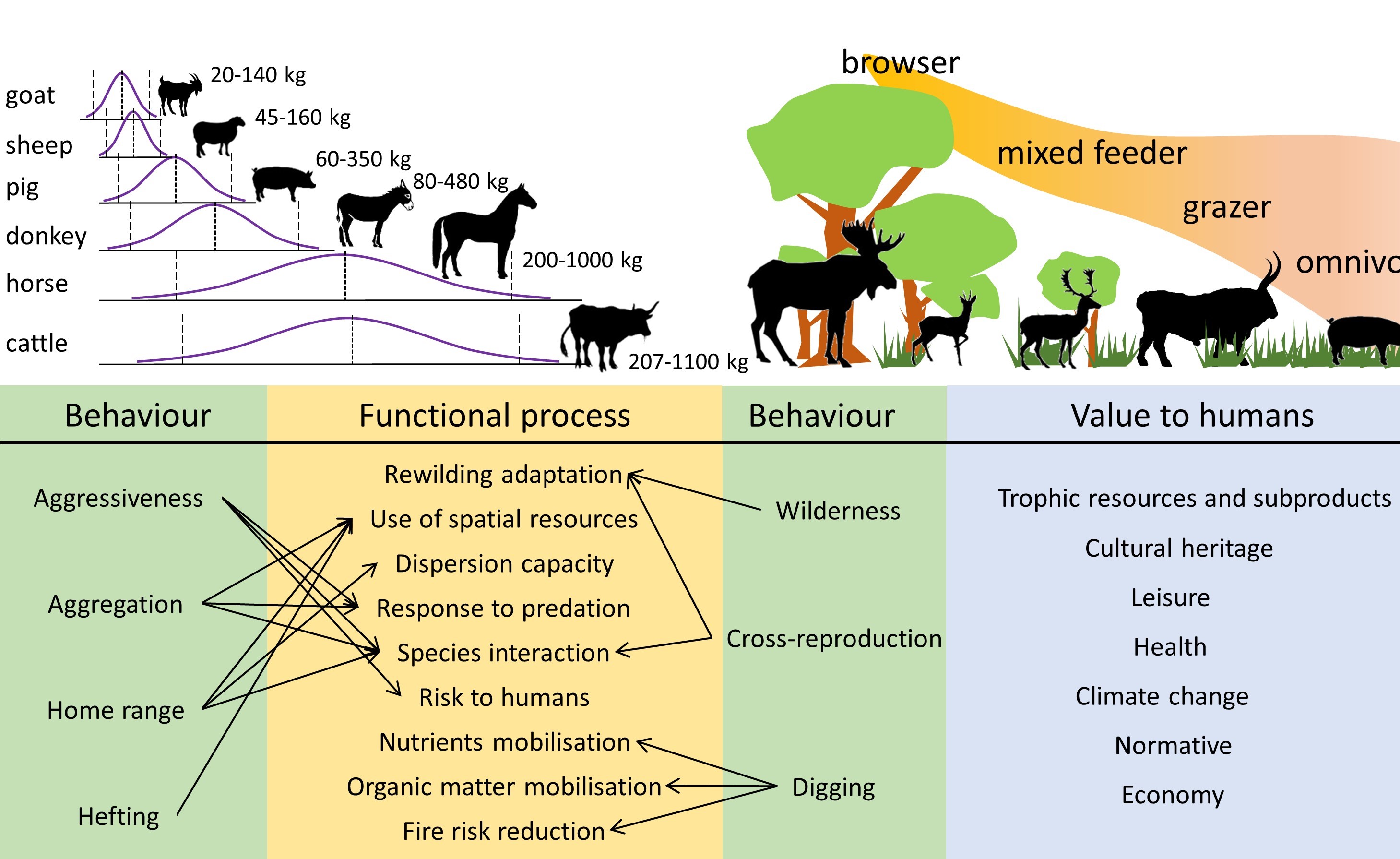 Fig.2 - What species where? Species and breeds of domestic livestock can be classified according to their potential functional role – a function of their body size, feeding style and behaviour, and their benefits for humans – in a particular environment[4].
Fig.2 - What species where? Species and breeds of domestic livestock can be classified according to their potential functional role – a function of their body size, feeding style and behaviour, and their benefits for humans – in a particular environment[4].Everyone's a winner
As the area of the countryside either under rewilding projects or soon to be transitioned to rewilding grows, it is important to determine how best to implement rewilding and to understand societal attitudes towards it. As rewilding projects roll out across our countryside, let us not let the perfect be the enemy of the pragmatic – rewilding lite need not necessarily risk the wrath of the public and can be implemented in situations where rewilding max is too difficult to implement. If a rewilding lite approach is adopted, it can offer broad benefits to society from rewilding spaces: large swathes of countryside can be given over to conservation and farmers will still be able to sell products from their stock – a much-needed ‘win-win’ for traditional enemies in the land use arena.
Iain Gordon FRSB is a wildlife ecologist at the Australian National University currently working
on rewilding projects in Australia.
1) Johns, D. History of rewilding: ideas and practice. In Rewilding (eds Pettorelli, N. et al), 12–33 (Cambridge University Press, Cambridge, UK, 2019).
2) Noss, R.F. The Wildlands Project: land conservation strategy. Wild Earth Special Issue 10, e25 (1992).
3) Carver, S. Making real space for nature: A continuum approach to UK conservation. ECOS 35, 4–14 (2014).
4) Gordon, I.J. et al. Rewilding lite: using traditional domestic livestock to achieve rewilding outcomes. Sustainability 13, 3347. www.doi.org/10.3390/su13063347 (2021a).
5) Gordon, I.J. et al. Domestic livestock and rewilding: are they mutually exclusive? Front. Sustain. Food Syst. 5, 550410. www.doi.org/10.3389/fsufs.2021.550410 (2021b).
6) Kopnina, H. et al. Learning to rewild: examining the failed case of the Dutch ‘New Wilderness’ Oostvaardersplassen. Int. J. Wilderness 25, 72–89 (2019).
7) Lesslie, R.G. & Taylor, S.G. The wilderness continuum concept and its implications for Australian wilderness preservation policy. Biol. Conserv. 32, 309–333 (1985).
8) Noss, R.F. & and Harris, L.D. Nodes, networks, and MUMs: Preserving diversity at all scales. Environ. Manag. 10, 299–309 (1986).


